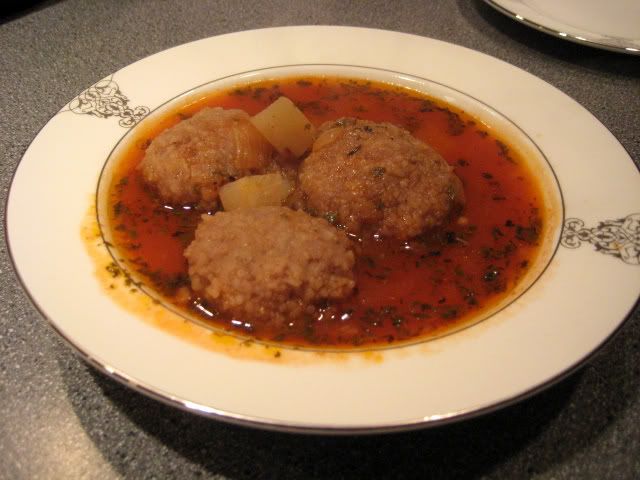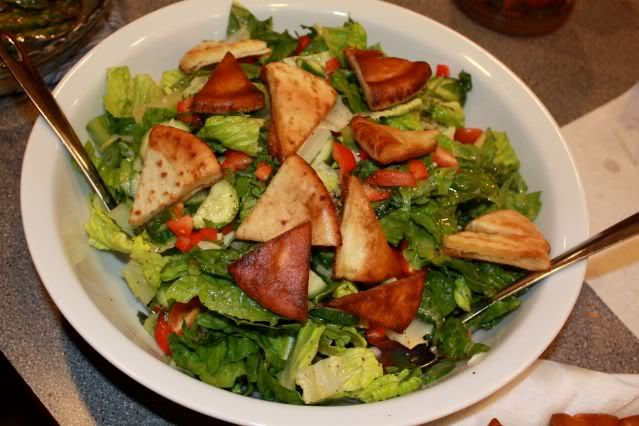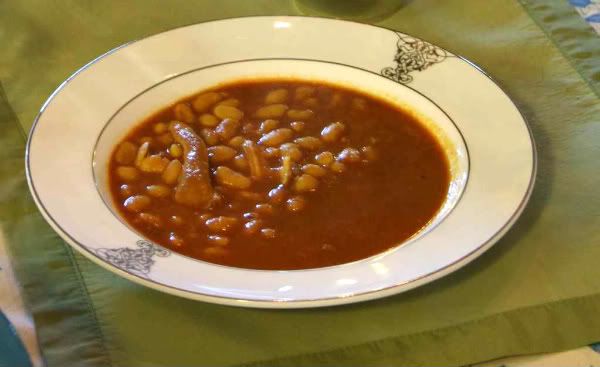
This is my husband's second favorite kubba, keeping in mind that the entire kubba genre is his overall favorite food of all time. That translates to some pretty good stuff.
This recipe could also use some tweaking to fit the original purpose of the blog: detailed recipes that anyone could follow...no expertise needed. But it could be a while before I make this again, so I'm publishing, and that's final. At least until I post a revised version, as I am wont to do.
I've seen vastly different recipes in books and on the internet, and have talked with different fantastic cooks, including my sweet mother-in-law (my go-to expert). This recipe combines my favorite elements of each version, while still staying true to the basics...lamb broth, turnips, lemon juice and mint. I admit, however, I prefer mine less tart than the Scientist likes...so I serve it with an extra half of lemon on the side so he can pucker it up to his liking. This strategy works for us since one can always make this more sour according to taste, but it's trickier to reduce the acidity. Note: he still says that's cheating...if it's not sour, it's not kubba hamuth, 'cause hamuth means sour! Sorry, Baby. I love you!
serves 4
1/2 medium onion, finely chopped
1 T. vegetable oil
2 lamb shoulder chops, with bone, about 3/4 lb. each
salt and freshly ground pepper
3 turnips, peeled and cut in bite-sized pieces (I like 3/4")
9 cups water, plus more
1/4 cup tomato paste (Tukas brand, if possible)
3/4 tsp. dried mint, or to taste
the juice of 2 lemons
salt and pepper, to taste
12 kubba
In large Dutch oven over medium-high heat, heat oil, then saute onions until lightly browned. Meanwhile, salt and pepper both sides of the lamb shoulder chops. Push onions to the side of the Dutch oven and brown the meat on both sides.
Add water, turnips, salt and pepper. Bring to a boil, then reduce heat and simmer 45 minutes, or until the turnips are tender and the flavor of the broth has deepened. Taste and adjust salt and pepper frequently. The turnips absorb a lot of salt, so don't be afraid to adjust the seasonings more than once.
Stir in tomato paste, then add mint and lemon juice. These go in towards the end because their flavors are more delicate and the long boiling affects their flavor.
Drop kubba into boiling sauce and cook on medium-high heat until they float to the top, about 10 minutes or more.
Serve with rice and a green salad.
Enjoy!
















 Roll call: Lamb, bay leaves, cinnamon sticks, cardamon, black peppercorns, whole allspice, cloves, a head of garlic, salt, and tomato paste (Tomato Paste was absent on picture day)
Roll call: Lamb, bay leaves, cinnamon sticks, cardamon, black peppercorns, whole allspice, cloves, a head of garlic, salt, and tomato paste (Tomato Paste was absent on picture day) Wash and trim excess fat and silver membrane from the leg of lamb.
Wash and trim excess fat and silver membrane from the leg of lamb.  With a long, thin, sharp knife, gouge a deep hole into the meat for each garlic clove you'll later insert. Arrange pieces of lamb in dutch oven. Shown here is a pressure cooker, but we didn't pressurize this recipe. I suspect this would be a great crock pot recipe, and will post and update after trying.
With a long, thin, sharp knife, gouge a deep hole into the meat for each garlic clove you'll later insert. Arrange pieces of lamb in dutch oven. Shown here is a pressure cooker, but we didn't pressurize this recipe. I suspect this would be a great crock pot recipe, and will post and update after trying. Fill the pot with water to within 1 1/2 inches of the top of the meat. Cover and bring to a boil. Remove pot from heat, discard water, set the lamb aside, and scrub the scum out of the pot. Mama chooses to do this, despite some people's assertions that it weakens the flavor of the lamb. I initially was on the side of NOT throwing out the first boil, but after tasting the final product, decided the flavor was plenty fantastic, and there indeed was less meat scum to deal with.
Fill the pot with water to within 1 1/2 inches of the top of the meat. Cover and bring to a boil. Remove pot from heat, discard water, set the lamb aside, and scrub the scum out of the pot. Mama chooses to do this, despite some people's assertions that it weakens the flavor of the lamb. I initially was on the side of NOT throwing out the first boil, but after tasting the final product, decided the flavor was plenty fantastic, and there indeed was less meat scum to deal with. Meanwhile, peel 9-10 garlic cloves.
Meanwhile, peel 9-10 garlic cloves. After discarding the water, return the meat to the pot and push the garlic down into the knife holes made previously. Widen the holes if necessary.
After discarding the water, return the meat to the pot and push the garlic down into the knife holes made previously. Widen the holes if necessary. Put the spices and the rest of the garlic into the pot, cover, boil hard for about 1 hour, then add salt.
Put the spices and the rest of the garlic into the pot, cover, boil hard for about 1 hour, then add salt. Simmer for another hour.
Simmer for another hour. Add tomato paste and simmer 1-2 more hours until you're ready to eat.
Add tomato paste and simmer 1-2 more hours until you're ready to eat.
 Soak rice overnight to achieve the proper consistency.
Soak rice overnight to achieve the proper consistency. Drain the rice.
Drain the rice. Transfer soaked rice to a food processor. Note to Self: I want a new food processor for Christmas next year. Essence of electrical burning is not my idea of a pleasin' kitchen aroma.
Transfer soaked rice to a food processor. Note to Self: I want a new food processor for Christmas next year. Essence of electrical burning is not my idea of a pleasin' kitchen aroma. Add salt and pepper. It's important to do this often as you add more ingredients, to ensure a proper balance between rice, meat, salt, and spice.
Add salt and pepper. It's important to do this often as you add more ingredients, to ensure a proper balance between rice, meat, salt, and spice. Run the food processor until the rice becomes somewhat granular.
Run the food processor until the rice becomes somewhat granular. While still running the food processor, start adding beef, a handful at a time. For the shell, we have used lean ground beef. Why lean? It's preferable to more fatty varieties because it helps ensure that the shell holds its shape while it's being boiled. Fat acts more as a tenderizer/lubricant than a glue here. You need a little, but too much in the outer shell raises the chances of the kibbe disintegrating while they boil. After all this work, you're going to be sad (and maybe mad) if things fall apart. Since food should make you happy, be picky about your beef.
While still running the food processor, start adding beef, a handful at a time. For the shell, we have used lean ground beef. Why lean? It's preferable to more fatty varieties because it helps ensure that the shell holds its shape while it's being boiled. Fat acts more as a tenderizer/lubricant than a glue here. You need a little, but too much in the outer shell raises the chances of the kibbe disintegrating while they boil. After all this work, you're going to be sad (and maybe mad) if things fall apart. Since food should make you happy, be picky about your beef.  Handful by handful, keep adding ground beef, keeping an eye on the coloring. You want a nice pink (not red) mix.
Handful by handful, keep adding ground beef, keeping an eye on the coloring. You want a nice pink (not red) mix. The goal is to have a thick, sticky but workable mixture, so add a little water if it seems like it's dry and grainy vs. sticky.
The goal is to have a thick, sticky but workable mixture, so add a little water if it seems like it's dry and grainy vs. sticky. You're done when the color is like this. I've given quantity guidelines in the ingredients here, but next time I make kubba I'll carefully measure so I can make a more exact recommendation on the proportion of rice to meat, for those of us who like things to be precise and measured.
You're done when the color is like this. I've given quantity guidelines in the ingredients here, but next time I make kubba I'll carefully measure so I can make a more exact recommendation on the proportion of rice to meat, for those of us who like things to be precise and measured. For the filling, use 80-85% lean beef. A fattier grade of ground beef is needed for the filling because it should have a marked contrast in color, flavor, and texture from the shell. In the words of my father-in-law, the filling should be "fluffy." In a beefy sort of way.
For the filling, use 80-85% lean beef. A fattier grade of ground beef is needed for the filling because it should have a marked contrast in color, flavor, and texture from the shell. In the words of my father-in-law, the filling should be "fluffy." In a beefy sort of way.  This shows the contrast in color between the shell and the filling.
This shows the contrast in color between the shell and the filling.  Have a bowl of ice water nearby to wet your hands if they get too sticky to work with, which they invariably do.
Have a bowl of ice water nearby to wet your hands if they get too sticky to work with, which they invariably do.  With your thumb or finger, poke a hole in the ball and then pinch the sides until you've transformed your ball into a bowl (remember ceramics class?).
With your thumb or finger, poke a hole in the ball and then pinch the sides until you've transformed your ball into a bowl (remember ceramics class?). Now pinch a glob of filling and deposit it into your nice little bowl. The blob of meat should be almost (but not quite) as big as the original shell glob, ensuring that there will be enough filling to flavor the kubba without making it impossible to close the shell around the filling.
Now pinch a glob of filling and deposit it into your nice little bowl. The blob of meat should be almost (but not quite) as big as the original shell glob, ensuring that there will be enough filling to flavor the kubba without making it impossible to close the shell around the filling. Now fold the sides of the shell over to encapsulate the filling. This may take some practice, but believe me, you'll get the hang of it if you stick with it (get it? stick? 'cause it's...never mind.)
Now fold the sides of the shell over to encapsulate the filling. This may take some practice, but believe me, you'll get the hang of it if you stick with it (get it? stick? 'cause it's...never mind.) Get all those edges folded over the top and smooth them down a little.
Get all those edges folded over the top and smooth them down a little. Next, between your hands, gently press the little ball until it's somewhat on the flat side...think flying saucer.
Next, between your hands, gently press the little ball until it's somewhat on the flat side...think flying saucer. Now you're done! And isn't it cute. Now just repeat this about a hundred times. HA! No really...do it. And think of what a domestic diva you're becoming. And about how happy that man of yours is gonna be when he sinks his teeth into one of these. And about how you only have to do this a couple of times a year if you play your cards right, because these babies freeze like a charm. You don't even have to defrost them before plopping them into the sauce when cooking time rolls around.
Now you're done! And isn't it cute. Now just repeat this about a hundred times. HA! No really...do it. And think of what a domestic diva you're becoming. And about how happy that man of yours is gonna be when he sinks his teeth into one of these. And about how you only have to do this a couple of times a year if you play your cards right, because these babies freeze like a charm. You don't even have to defrost them before plopping them into the sauce when cooking time rolls around. Layer the kibbe on plastic wrap (I haven't tried parchment paper, but I wonder if that would work, considering these are going in the freezer?), being sure they aren't touching. Since they're kinda flat anyhow, don't worry about laying them on top of each other. No harm done if they get a little flatter.
Layer the kibbe on plastic wrap (I haven't tried parchment paper, but I wonder if that would work, considering these are going in the freezer?), being sure they aren't touching. Since they're kinda flat anyhow, don't worry about laying them on top of each other. No harm done if they get a little flatter. When all the outer shell is gone, you're done! Finito! Hallas! Now if you have a sauce prepared, plop however many kubba you want into the pot and boil until they float to the top. Cooking time varies depending on the size of your kubba, but when they rise to the top, try one...it's probably done. Meanwhile, put the rest into the freezer. Once they've hardened, transfer them into a dated ziplock bag and pull them out as needed.
When all the outer shell is gone, you're done! Finito! Hallas! Now if you have a sauce prepared, plop however many kubba you want into the pot and boil until they float to the top. Cooking time varies depending on the size of your kubba, but when they rise to the top, try one...it's probably done. Meanwhile, put the rest into the freezer. Once they've hardened, transfer them into a dated ziplock bag and pull them out as needed.